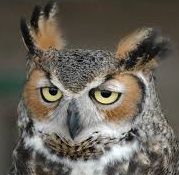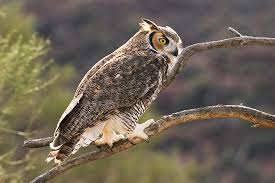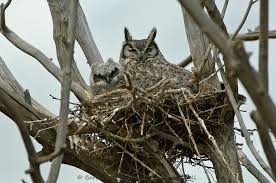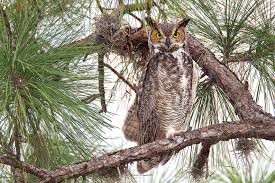
Great horned owl
(Bubo virginianus)

The great horned owl, also known as the tiger owl (originally derived from early naturalists' description as the "winged tiger" or "tiger of the air") or the hoot owl, is a large owl native to the Americas. It is an extremely adaptable bird with a vast range and is the most widely distributed true owl in the Americas. Its primary diet appears to be rabbits and hares, rats and mice and voles, although it freely hunts any animal it can overtake, primarily rodents and other small mammals, but also larger mid-sized mammals, various birds, reptiles, amphibians and invertebrates. In ornithological study, the great horned owl is often compared to the Eurasian eagle-owl (Bubo bubo), a closely related species which, despite the latter's notably larger size, occupies the same ecological niche in Eurasia, and the red-tailed hawk (Buteo jamaicensis), with which it often shares similar habitat, prey and nesting habits by day and is thus something of a diurnal ecological equivalent. The great horned owl is one of the earliest nesting birds in North America, often laying eggs weeks or even months before other raptorial birds.
Conservation status
Least concern
Scientific classification |
|
| Kingdom: | Animalia |
| Phylum: | Chordata |
| Class: | Aves |
| Order: | Strigiformes |
| Family: | Strigidae |
| Genus: | Bubo |
| Specie: | Bubo virginianus |
Description

The great horned owl is generally colored for camouflage. The underparts of the species are usually light with some brown horizontal barring; the upper parts and upper wings are generally a mottled brown usually bearing heavy, complex darker markings. All subspecies are darkly barred to some extent along the sides as well. There is a variable sized white patch on the throat. The white throat may continue as a streak running down the middle of the breast even when the birds are not displaying, which in particularly pale individuals can widen at the belly into a large white area. South American horned owls typically have a smaller white throat patch, often unseen unless actively displaying, and rarely display the white area on the chest. There are individual and regional variations in overall color, with birds from the subarctic showing a washed-out, light-buff color, while those from the Pacific Coast of North America, Central America and much of South America can be a dark brownish color overlaid with blackish blotching. The skin of the feet and legs, though almost entirely obscured by feathers, is black. Even tropical great horned owls have feathered legs and feet. The feathers on the feet of the great horned owl are the second longest known in any owl (after the snowy owl). The bill is dark gunmetal-gray, as are the talons.

All great horned owls have a facial disc. This can be reddish, brown or gray in color (depending on geographical and racial variation) and is demarked by a dark rim culminating in bold, blackish side brackets. This species' "horns" are tufts of feathers, called plumicorns. The purpose of plumicorns is not fully understood, but the theory that they serve as a visual cue in territorial and socio-sexual interactions with other owls is generally accepted.
Distribution and habitat

The breeding habitat of the great horned owl extends high into the subarctic of North America, where they are found up to the northwestern and southern Mackenzie Mountains, Keewatin, Ontario, northern Manitoba, Fort Chimo in Ungava, Okak, Newfoundland and Labrador, Anticosti Island and Prince Edward Island. They are distributed throughout most of North and very spottily in Central America and then down into South America south to upland regions of Argentina, Bolivia and Peru, before they give way to the Magellanic horned owl, which thence ranges all the way to Tierra del Fuego, the southern tip of the continent. It is absent or rare from southern Guatemala, El Salvador, Nicaragua, and Costa Rica to Panama (where only two records) in Central America and the mangrove forests of northwestern South America. The species is also absent from the West Indies, the Queen Charlotte Islands and almost all off-shore islands in the Americas, its ability to colonize islands apparently being considerably less than those of barn owls and short-eared owls. Since the division into two species, the great horned owl is the second most widely distributed owl in the Americas, just after the barn owl.
The great horned owl is among the world's most adaptable owls or even bird species in terms of habitat. The great horned owl can take up residence in trees that border all manner of deciduous, coniferous, and mixed forests, tropical rainforests, pampas, prairie, mountainous areas, deserts, subarctic tundra, rocky coasts, mangrove swamp forests, and some urban areas. It is less common in the more extreme areas of the Americas. In the Mojave and Sonora Deserts, they are absent from the heart of the deserts and are only found on the vegetated or rocky fringes. Even in North America, they are rare in landscapes including more than 70% old-growth forest, such as the aspen forest of the Rockies. They have only been recorded a handful of times in true rainforests such as Amazonia. In the Appalachian Mountains, they appear to use old-growth forest but in Arkansas are actually often found near temporary agricultural openings in the midst of large areas of woodland. Similarly in south-central Pennsylvania, the owls uses cropland and pasture more than deciduous and total forest cover, indicating preference for fragmented landscapes. In prairies, grasslands and deserts, they can successfully live year around as long as there are rocky canyon, steep gullies and/or wooded coulees with shade-giving trees to provide them shelter and nesting sites.
In mountainous areas of North America, they are usually absent above the tree line, but great horned owls can be found up to 2,100 m (6,900 ft) in California and 3,300 m (10,800 ft) in the Rockies. In the Andean Mountains, on the other hand, they have adapted to being true montane species, often found at least 3,300 m (10,800 ft) above sea level and are regularly recorded in treeless Puna grassland zones at 4,100 to 4,500 m (13,500 to 14,800 ft) in Ecuador and Peru. They are generally rare in non-tidal wetland habitat, and are replaced in the high Arctic tundra by snowy owls. It prefers areas where open habitats, which it often hunts in, and woods, where it tends to roost and nest, are juxtaposed. Thus lightly populated rural regions can be ideal. This species can occasionally be found in urban or suburban areas. However, it seems to prefer areas with less human activity and is most likely to be found in park-like settings in such developed areas, unlike eastern and western screech owls which may regularly occur in busy suburban settings. On the contrary, though, one nest (a large squirrel nest) was reported in a tree in the middle of a college campus, under which no fewer than 3,000-4,000 people passed directly each day. All mated great horned owls are permanent residents of their territories, but unmated and younger birds move freely in search of company and a territory, and leave regions with little food in winter.
Bejavior

In most aspects of their behavior, great horned owls are typical of owls and most birds of prey. From experimentally raising young owls in captivity, Paul L. Errington felt that they were a bird of "essentially low intelligence" who could only hunt when partially wild and instinctually driven by hunger to hunt whatever they first encounter. He showed captive birds that were provided strips of meat from hatching, rather than having to hunt or to simulate hunting to obtain food, had no capacity to hunt. On the contrary, William J. Baerg compared his captive raised behaviorally great horned owls to parrots, which are famously intelligent birds, although not as often playful it knows its keeper and usually accepts whatever he wishes to do with a good deal of tolerance. Arthur C. Bent also noted the variability in temperaments of great horned owls to their handlers, some generally pleasant, though most are eventually aggressive. Most captive specimens, once mature, seem to resent attempts at contact and are often given to attacking their keepers. They will only follow cues when conditioned from an early age but rarely with the same level of success seen in some diurnal birds of prey trained for falconry or entertainment, although this does not necessarily correlate with intelligence as posited by Errington. Carl D. Marti also disagrees with Errington's assessments, noting that their prey selection is not as "completely random as Errington suggested"; while "Great Horned Owls appeared to select their mammalian prey in general relation to the prey populations...Cottontails, appeared to be selected as prey out of relation to their population status.
Like most owls, the great horned owl makes great use of secrecy and stealth. Due to its natural-colored p lumage, it is well camouflaged both while active at night and while roosting during the day. During the daytime it roosts usually in large trees (including snags and large hollows but usually thick branches) but may occasionally be in crevices or small caves in rocks or in dense shrubbery. Pine and other coniferous trees may be preferred where available since they are particularly dense and provide cover throughout the year. Typically, males have a favorite roosting site not far from the nest, sometimes used over successive years. While roosting, great horned owls may rest in the "tall-thin" position, where they sit as erect and hold themselves as slim as is possible. The kind of posture is well known as a further method of camouflage for other owls, like long-eared owls or great grey owls, especially if humans or other potential mammalian carnivores approach them. The Eurasian eagle owl rarely, if ever, assumes the tall-thin position. Outside of the nesting season, great horned owls may roost wherever their foraging path ends at dawn. Generally great horned owls are active at night, although in some areas may be active in the late afternoon or early morning. At dusk, the owl utters a few calls before flying to a more open sing-post, i.e. large bare branch or large rocks to deliver song. Normally several perches are used to mark occupied territory or to attract a female. Despite its camouflage and cryptic locations, this species can still sometimes be spotted on its daytime roosts, especially by American crows (Corvus brachyrhynchos). Since owls are, next to red-tailed hawks, perhaps the main predator of crows and their young, crows sometimes congregate from considerable distances to mob owls and caw angrily at them for hours on end. When the owls try to fly off to avoid this harassment, they are often followed by the corvids.
Zoológico de Vallarta A. C.
Leave your comments, your opinion is important to us

